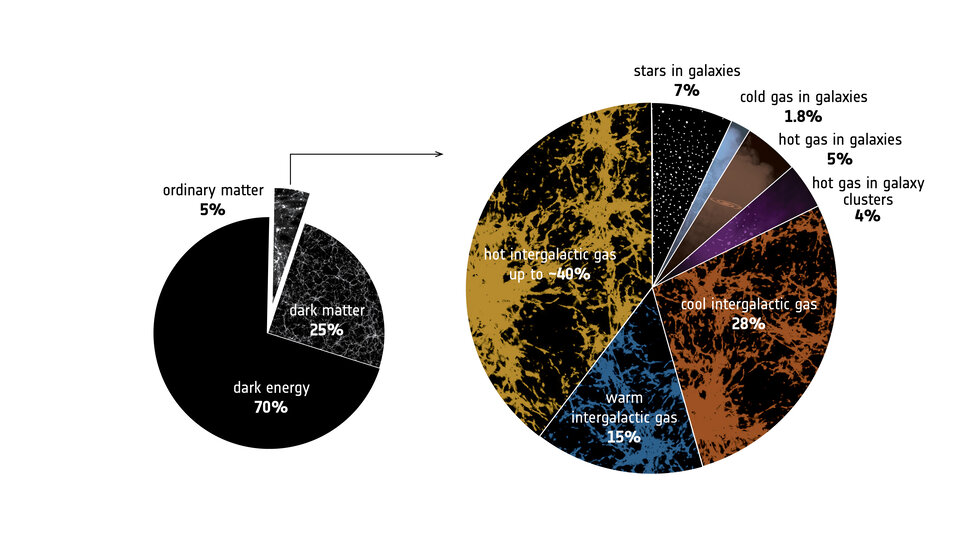19/06/2025 2597 views 21 likes
Astronomers have discovered a huge filament of hot gas bridging four galaxy clusters. At 10 times as massive as our galaxy, the thread could contain some of the Universe’s ‘missing’ matter, addressing a decades-long mystery.
The astronomers used the European Space Agency’s XMM-Newton and JAXA’s Suzaku X-ray space telescopes to make the discovery.
Over one-third of the ‘normal’ matter in the local Universe – the visible stuff making up stars, planets, galaxies, life – is missing. It hasn’t yet been seen, but it’s needed to make our models of the cosmos work properly.
Said models suggest that this elusive matter might exist in long strings of gas, or filaments, bridging the densest pockets of space. While we’ve spotted filaments before, it’s tricky to make out their properties; they’re typically faint, making it difficult to isolate their light from that of any galaxies, black holes, and other objects lying nearby.
New research is now one of the first to do just this, finding and accurately characterising a single filament of hot gas stretching between four clusters of galaxies in the nearby Universe.
 The filament is made up of hot intergalactic gas (shown in mottled black-yellow), a type of ‘ordinary matter’ that has proven really difficult for astronomers to find.
The filament is made up of hot intergalactic gas (shown in mottled black-yellow), a type of ‘ordinary matter’ that has proven really difficult for astronomers to find.
“For the first time, our results closely match what we see in our leading model of the cosmos – something that’s not happened before,” says lead researcher Konstantinos Migkas of Leiden Observatory in the Netherlands. “It seems that the simulations were right all along.”
XMM-Newton on the case
Clocking in at over 10 million degrees, the filament contains around 10 times the mass of the Milky Way and connects four galaxy clusters: two on one end, two on the other. All are part of the Shapley Supercluster, a collection of more than 8000 galaxies that forms one of the most massive structures in the nearby Universe.
The filament stretches diagonally away from us through the supercluster for 23 million light-years, the equivalent of traversing the Milky Way end to end around 230 times.


Open Image
Konstantinos and colleagues characterised the filament by combining X-ray observations from XMM-Newton and Suzaku, and digging into optical data from several others.
The two X-ray telescopes were ideal partners. Suzaku mapped the filament’s faint X-ray light over a wide region of space, while XMM-Newton pinpointed very precisely contaminating sources of X-rays – namely, supermassive black holes – lying within the filament.
“Thanks to XMM-Newton we could identify and remove these cosmic contaminants, so we knew we were looking at the gas in the filament and nothing else,” adds co-author Florian Pacaud of the University of Bonn, Germany. “Our approach was really successful, and reveals that the filament is exactly as we’d expect from our best large-scale simulations of the Universe.”
Not truly missing
As well as revealing a huge and previously unseen thread of matter running through the nearby cosmos, the finding shows how some of the densest and most extreme structures in the Universe – galaxy clusters – are connected over colossal distances.
It also sheds light on the very nature of the ‘cosmic web’, the vast, invisible cobweb of filaments that underpins the structure of everything we see around us.
 Simulation of the cosmic web
Simulation of the cosmic web
“This research is a great example of collaboration between telescopes, and creates a new benchmark for how to spot the light coming from the faint filaments of the cosmic web,” adds Norbert Schartel, ESA XMM-Newton Project Scientist.
“More fundamentally, it reinforces our standard model of the cosmos and validates decades of simulations: it seems that the ‘missing’ matter may truly be lurking in hard-to-see threads woven across the Universe.”
Piecing together an accurate picture of the cosmic web is the domain of ESA’s Euclid mission. Launched in 2023, Euclid is exploring this web’s structure and history. The mission is also digging deep into the nature of dark matter and energy – neither of which have ever been observed, despite accounting for a whopping 95% of the Universe – and working with other dark Universe detectives to solve some of the biggest and longest-standing cosmic mysteries.
.png)




